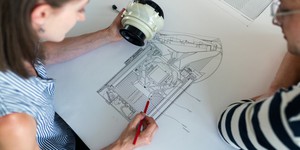Log In
Summary
*Note:
For this science project you will need to develop your own experimental procedure. Use the information in the summary tab as a starting place. If you would like to discuss your ideas or need help troubleshooting, use the Ask An Expert forum. Our Experts won't do the work for you, but they will make suggestions and offer guidance if you come to them with specific questions.
If you want a Project Idea with full instructions, please pick one without an asterisk (*) at the end of the title.
If you want a Project Idea with full instructions, please pick one without an asterisk (*) at the end of the title.
Abstract
Use a video camera to analyze the angle of lift with different clubs. Measure the distance the ball travels. Be sure to conduct a sufficient number of trials with each club so that your results are consistent. This can also be a great way to work on your swing! (Idea from Goodstein, 1999, 83-85.)Bibliography
Goodstein, M., 1999. Sports Science Projects: The Physics of Balls in Motion. Berkeley Heights, NJ: Enslow Publishers.Ask an Expert
Do you have specific questions about your science project? Our team of volunteer scientists can help. Our Experts won't do the work for you, but they will make suggestions, offer guidance, and help you troubleshoot.
Careers
If you like this project, you might enjoy exploring these related careers:
Career Profile
Physicists have a big goal in mind—to understand the nature of the entire universe and everything in it! To reach that goal, they observe and measure natural events seen on Earth and in the universe, and then develop theories, using mathematics, to explain why those phenomena occur. Physicists take on the challenge of explaining events that happen on the grandest scale imaginable to those that happen at the level of the smallest atomic particles. Their theories are then applied to…
Read more
Career Profile
Mechanical engineers are part of your everyday life, designing the spoon you used to eat your breakfast, your breakfast's packaging, the flip-top cap on your toothpaste tube, the zipper on your jacket, the car, bike, or bus you took to school, the chair you sat in, the door handle you grasped and the hinges it opened on, and the ballpoint pen you used to take your test. Virtually every object that you see around you has passed through the hands of a mechanical engineer. Consequently, their…
Read more
Career Profile
Statisticians use the power of math and probability theory to answer questions that affect the lives of millions of people. They tell educators which teaching method works best, tell policy-makers what levels of pesticides are acceptable in fresh fruit, tell doctors which treatment works best, and tell builders which type of paint is the most durable. They are employed in virtually every type of industry imaginable, from engineering, manufacturing, and medicine to animal science, food…
Read more
Career Profile
You use mechanical devices every day—to zip and snap your clothing, open doors, refrigerate and cook your food, get clean water, heat your home, play music, surf the Internet, travel around, and even to brush your teeth. Virtually every object that you see around has been mechanically engineered or designed at some point, requiring the skills of mechanical engineering technicians to create drawings of the product, or to build and test models of the product to find the best design.
Read more
Related Links
Cite This Page
General citation information is provided here. Be sure to check the formatting, including capitalization, for the method you are using and update your citation, as needed.MLA Style
Science Buddies Staff.
"Golf Clubs, Loft Angle, and Distance: The Science of Hitting." Science Buddies,
20 Nov. 2020,
https://www.sciencebuddies.org/science-fair-projects/project-ideas/Sports_p029/sports-science/golf-clubs-loft-angle-and-distance?class=AQUCQMaZpex2_ILuHdo1NVBmnghZGbbF18uyFeU3G_c3sDTVNWyZZlInwjSlNju1ht2Aw03fpu3cOuysjnG3zWpzalT0wxt-jRMI1bEWnemEJQ.
Accessed 26 Apr. 2024.
APA Style
Science Buddies Staff.
(2020, November 20).
Golf Clubs, Loft Angle, and Distance: The Science of Hitting.
Retrieved from
https://www.sciencebuddies.org/science-fair-projects/project-ideas/Sports_p029/sports-science/golf-clubs-loft-angle-and-distance?class=AQUCQMaZpex2_ILuHdo1NVBmnghZGbbF18uyFeU3G_c3sDTVNWyZZlInwjSlNju1ht2Aw03fpu3cOuysjnG3zWpzalT0wxt-jRMI1bEWnemEJQ
Last edit date: 2020-11-20
Explore Our Science Videos
Ion Wind Rotor V2
Why Do Apples and Bananas Turn Brown? - STEM activity
Making Shadow Puppets – STEM Activity










